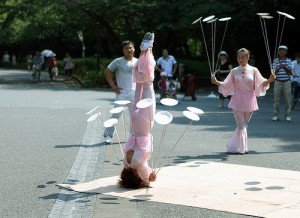As a Project Manager, how many times have you had this conversation?
Person: “So what are you doing these days?”
You: “I’m a Project Manager.”
Person: “Oh, cool!”
You: “Yes, I really enjoy it.”
Person: “So… what do you do?”
Project Management is a very difficult line of work to describe in terms that every person can understand. My husband, an IT Director for a non-profit, can distill what he does into four words: I work with computers. That explanation doesn’t cover exactly what he does, but it is enough to get an understanding nod and allow the conversation to move on to other things. Project Managers don’t have the luxury of distilling their work like that. I manage projects doesn’t really clarify anything, and it breaks the rule of definitions by using the same words to define the word or phrase in question. What does it mean to manage? Do people report to you? (not always) What is a Project? (something with a beginning and end) Suddenly, you find yourself explaining the definition of a project, and the complexities of a Project Management Plan, and the person you’re talking to is no closer to understanding what your career is. The quickest answer I can usually come up with is “I get all of the work done on projects without doing any of the actual work”, which is the best description I have of what I do.

Saying that your job is to not do any work may seem a bit odd, but bare with me for a moment. Think about a Construction Project Manager. Do they actually build anything? Do they install any electrical or plumbing? Most likely not. Project Managers are there to make sure that the Carpenters, Electricians, Plumbers, Painters, Stone Masons, etc. all know what they are supposed to be working on, and when they need to be finished so that the next set of people can come in and do their magic. If something happens and someone is slipping on a deadline, it’s the Project Manager’s job to make sure that the overall schedule can still be met by juggling the rest of the tasks (and the people that do them) in a new and interesting way so that the project can be completed on time. With Technology Project Management, Project Managers aren’t usually the Developers, QA Testers, Infrastructure Engineers, or Technicians. They manage the tasks and resources very similarly – by making sure that the Developers know when they need to be ready with a specific set of code so that the QA Team can get started, and so on and so forth. When I am at my busiest, I feel like a Plate Spinner – keeping a dozen plates in the air at any given time. If I let one drop, the rest will somehow follow suit. As a Project Manager, it’s important to know which plates to pick up, and how to keep them spinning until the project is complete.
Early in my Project Management career, I was often given the projects that were so far beyond recognition that there were few people that could imagine the project ever being completed, or if they even knew what it was about anymore. In retrospect, I think I was given these challenging projects because I had view of Project Management that always enabled me to get things back on track to completion. In my view, Project Managers need to wear a number of ‘hats’ to be successful:
- Leader Hat– In order to successfully manage projects, people need to follow you.
- Paver Hat – If you want a project to be successful, you need to get obstacles out of your team’s way, and make sure that they have a path to follow.
- Supporter Hat – As projects move forward, motivation and morale can dwindle. It’s important for a Project Manager to be able to support their team through the rough patches.
- Jester Hat – Things are always easier when you’re having fun. As the Project Manager, it is up to you to make sure that your team is having as good a time as possible.
Over the next few days, we’ll dive deeper into what to do with each Project Management hat, when to wear them, and how to make sure that your team can count on you to lead them to a successful project completion. Once you have an understanding of each hat, you should be able to improve your team’s morale, efficiency, and dedication to your projects. When you can successfully use these hats, Executive Sponsorship can be much easier to manage, projects tend to run much more smoothly, and you may find yourself being able to choose the next project that you work on, rather than having one arbitrarily assigned to you.


Oh, Abby, thank you for such a fresh look at a career I’ve been working in for decades! What DO we do? Good question! And your answer gave me new insights into my work. (I particularly like the jester hat!) Awesome, scrappy gal pal! Can’t wait to read your next post.